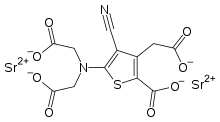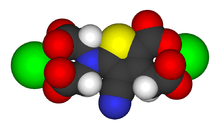Strontium ranelate
Strontium ranelate, a strontium(II) salt of ranelic acid, is a medication for osteoporosis marketed as Protelos or Protos by Servier. Studies indicate it can also slow the course of osteoarthritis of the knee.[1] The drug is unusual in that it both increases deposition of new bone by osteoblasts and reduces the resorption of bone by osteoclasts. It is therefore promoted as a "dual action bone agent" (DABA).
 | |
 | |
| Clinical data | |
|---|---|
| Trade names | Protelos, Osseor |
| AHFS/Drugs.com | UK Drug Information |
| License data | |
| Pregnancy category |
|
| Routes of administration | By mouth |
| ATC code | |
| Legal status | |
| Legal status |
|
| Pharmacokinetic data | |
| Bioavailability | 25% (range 19–27%) |
| Protein binding | 25% for plasma protein and high affinity for bone tissue |
| Metabolism | As a divalent cation, strontium is not metabolised. Does not inhibit cytochrome P450 enzymes |
| Elimination half-life | 60 hours |
| Excretion | Renal and gastrointestinal. Plasma clearance is about 12 ml/min (CV 22%) and renal clearance about 7 ml/min (CV 28%) |
| Identifiers | |
| |
| CAS Number | |
| PubChem CID | |
| ChemSpider | |
| UNII | |
| KEGG | |
| CompTox Dashboard (EPA) | |
| ECHA InfoCard | 100.218.275 |
| Chemical and physical data | |
| Formula | C12H6N2O8SSr2 |
| Molar mass | 513.491 g·mol−1 |
| 3D model (JSmol) | |
| |
| |
| | |
On 13 May 2013, Servier released a Direct Healthcare Professional Communication which stated that new restrictions for the use of strontium ranelate are now in place, as randomised trials have shown an increased risk of myocardial infarction. Servier states that the use is now restricted to treatment of severe osteoporosis in postmenopausal women at high risk for fracture.[2] The European Pharmacovigilance Risk Assessment Committee (PRAC) recommends restriction in the use of strontium ranelate, based on a routine benefit-risk assessment of the medicine, which included data showing an increased risk of heart problems, including heart attacks.[3] On 21 February 2014 the European Medicine Agency recommended that strontium ranelate remain available with restrictions relative to patients with existing heart disease.[4]
Uses
Strontium ranelate is registered as a prescription drug in more than 70 countries for the treatment of post-menopausal osteoporosis to reduce the risk of vertebral and hip fractures. In the United States, strontium ranelate is not approved by the FDA. In the United Kingdom, strontium ranelate is prescribed under the National Health Service as a medicine for the treatment of post menopausal osteoporosis.[5]
2 major phase III clinical studies, SOTI (Spinal Osteoporosis Therapeutic Intervention) and TROPOS (Treatment of Peripheral Osteoporosis), were started in 2000 to investigate the efficacy of strontium ranelate in reducing vertebral fractures and peripheral fractures, including hip fractures. In the 3 years results, reported in 2004, strontium ranelate showed significant reduction in vertebral fractures with 41% and hip fractures with 36% compared with patients treated with placebo.[6]
The efficacy was sustained in 5 years data. The 5 years data confirmed that strontium ranelate can reduce the vertebral fractures significantly no matter the risk factors of the osteoporotic women have. These include their age (<70, 70–80 and >80), bone mineral density (osteoporotic and osteopenia), prevalent fractures (0 prevalent fracture, 1–2 prevalent fractures and >2 prevalent fractures), symptomatic fractures, body mass index and smoking.
Strontium ranelate shows anti-fracture efficacy in very old elderly and osteopenic patients.
Contraindications
Strontium ranelate is contraindicated in hypersensitivity to the active substance or to any of the excipients. It is not recommended in patients with severe renal disease, i.e. creatinine clearance below 30 mL/min due to lack of data. Precaution is advised in patients at increased risk of venous thromboembolism (VTE), including patients with a history of VTE. Precaution is advised in patients with phenylketonuria, as formulations of strontium ranelate contain phenylalanine.[7] Precaution as it interferes with colorimetric measurements of calcium in blood and urine.
Side effects
Strontium ranelate increased the risk of venous thromboembolism, pulmonary embolism and serious cardiovascular disorders, including myocardial infarction. Its use is now restricted.[8] The most common side effects include nausea, diarrhea, headache and eczema, but with only 2–4% increase compared with placebo group. However, most of those side effects resolved within 3 months. Occasional severe allergic reactions have been reported including drug rash with eosinophilia and systemic symptoms (DRESS syndrome)[9]
Interactions
According to the manufacturer, strontium ranelate should be taken 2 hours apart from food, milk and derivative products, and medicinal products containing calcium. Should be taken 2 hours before antacids. Treatment should be suspended while taking oral tetracycline and quinolone antibiotics, as these chelate the strontium ion.
Pharmacology
Mechanism of action
Strontium, which has the atomic number 38, belongs to group II in the periodic table of elements, just beneath calcium. Because its nucleus is very nearly the same size as that of calcium, the body easily takes up strontium and incorporates it into bones and tooth enamel in place of calcium. This is not a health problem, and in fact, it can provide a health benefit. For example, in clinical trials, the drug strontium ranelate was found to aid bone growth, increase bone density, and lessen vertebral, peripheral, and hip fractures in women.
Strontium ranelate is an antiosteoporotic agent which both increases bone formation and reduces bone resorption, resulting in a rebalance of bone turnover in favor of bone formation. This is similar to the effects of choline-stabilized orthosilicic acid.[10][11]
Strontium ranelate stimulates the calcium-sensing receptors and leads to the differentiation of pre-osteoblast to osteoblast which increases the bone formation. Strontium ranelate also stimulates osteoblasts to secrete osteoprotegerin in inhibiting osteoclasts formed from pre-osteoclasts in relation to the RANKL system, which leads to the decrease of bone resorption.[12]
Research
A large international study, the "Strontium Ranelate Efficacy in Knee Osteoarthritis trial," or SEKOIA, reported in 2012 that the drug significantly slowed the course of knee OA compared to placebo in a double-blind ransomised controlled trial. The drug reduced knee OA pain symptoms, improved function, and reduced x-ray detectable cartilage loss, as shown by reductions in joint space narrowing over three years.[13]
References
- New osteoarthritis treatments on the horizon, from the May 2013 Harvard Women’s Health Watch
- http://www.imb.ie/EN/Publications/Publications/Protelos-strontium-ranelate-Important-Safety-Information-from-Servier-as-approved-by-the-Irish-Medicines-Board.aspx
- http://www.ema.europa.eu/docs/en_GB/document_library/Medicine_QA/human/000560/WC500142021.pdf
- http://www.ema.europa.eu/ema/index.jsp?curl=pages/news_and_events/news/2014/02/news_detail_002031.jsp&mid=WC0b01ac058004d5c1
- NHS Choices: Strontium Ranelate
- Meunier PJ, Roux C, Seeman E, Ortolani S, Badurski JE, Spector TD, Cannata J, Balogh A, Lemmel EM, Pors-Nielsen S, Rizzoli R, Genant HK, Reginster JY (2004). "The effects of strontium ranelate on the risk of vertebral fracture in women with postmenopausal osteoporosis" (PDF). New England Journal of Medicine. 350 (Jan 29): 459–68. doi:10.1056/NEJMoa022436. PMID 14749454.
- Protelos – European Medicines Agency – Europa.eu
- "Strontium ranelate: cardiovascular risk – restricted indication and new monitoring requirements Article date: March 2014". MHRA.
- "Drug Safety Update". Medicines and Healthcare products Regulatory Agency. May 2012. Archived from the original on 4 June 2012. Retrieved 22 January 2013.
- Spector, Tim (11 June 2008). "Choline-stabilized orthosilicic acid supplementation as an adjunct to Calcium/Vitamin D3 stimulates markers of bone formation in osteopenic females: a randomzed, placebo-controlled trial". BMC Musculoskeletal Disorders. 9 (85): 85. doi:10.1186/1471-2474-9-85. PMC 2442067. PMID 18547426.
- Calomme, M; et al. (13 Apr 2006). "Partial prevention of long-term femoralbone loss in aged ovariectomized rats supplemented with choline-stabilized orthosilicic acid". Calcif Tissue Int. 78 (4): 227–32. doi:10.1007/s00223-005-0288-0. PMID 16604283.
- Hamdy, Neveen (31 July 2009). "Strontium ranelate improves bone microarchitecture in osteoporosis" (PDF). Rheumatology. 48: iv9–iv13. doi:10.1093/rheumatology/kep274. PMID 19783592.
- Reginster JY, Badurski J, Bellamy N, Bensen W, Chapurlat R, Chevalier X, Christiansen C, Genant HK, Navarro F, Nasonov E, Sambrook PN, Spector TD, Cooper C (2012). "Efficacy and safety of strontium ranelate in the treatment of knee osteoarthritis: results of a double-blind, randomised placebo-controlled trial". Ann Rheum Dis. 72 (Online First, Nov 1): 179–86. doi:10.1136/annrheumdis-2012-202231. PMC 3599139. PMID 23117245.
Cessation of marketing of Protelos/Osseor: Extract of the letter sent to European Medicine Agency (EMA) and national European Agencies on 10 February 2017
External links
- PRAC recommends suspending use of Protelos/Osseor
- Protelos official site
- "First Head-To-Head Study Shows That Protelos(R) (Strontium Ranelate) Builds Better Bone Than Bisphosphonate". Medical News Today. 8 Dec 2008.